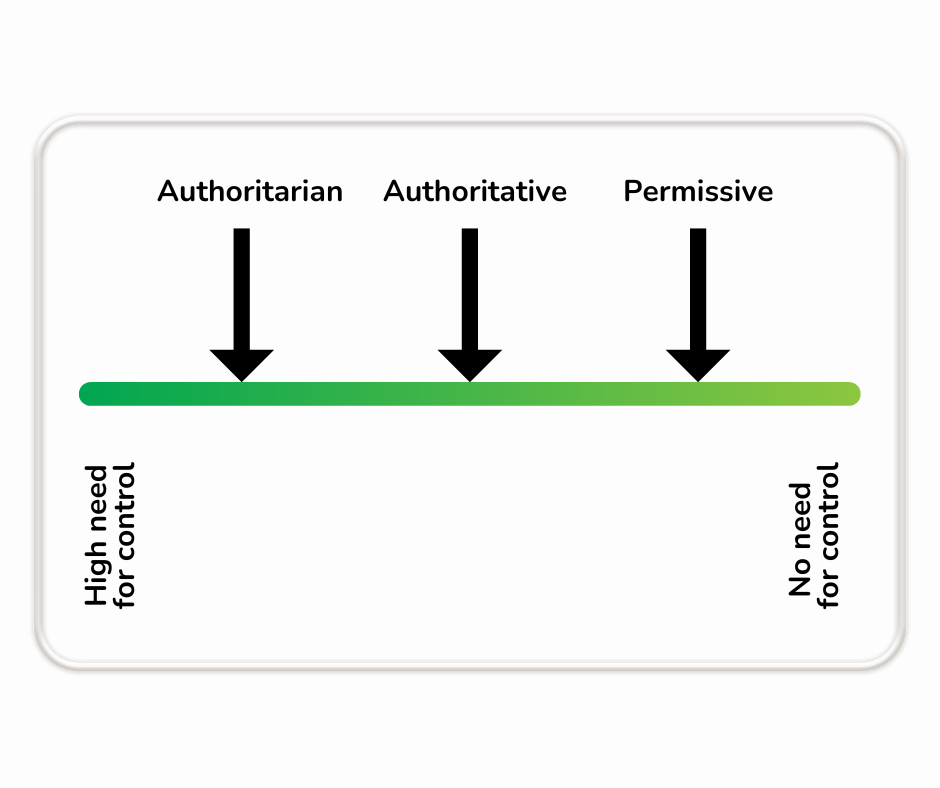In the 1960’s, psychologist, Diana Baumrind identified main parenting styles: Permissive, Authoritarian and Authoritative. For the most part, this categorization of parenting styles remains the framework for evaluating parent-child interactions today (researchers eventually added a fourth style called uninvolved or neglected). But because humans are not robots, we are not so easily placed into simple categories. It might be better to view parenting styles as along a continuum. Let’s consider the continuum and then look at what range on the continuum provides both the safety and structure that kids need to thrive and what style works best for your family.
We can view parenting styles through the lens of a continuum of control, with high need for control on one end and no need for control on the other.

The extreme ends of the parenting style continuum
At the extreme controlling end of this spectrum, are parents who are abusive and use threats and fear to control their child’s behavior.
On the other end of the continuum, are neglectful parents who have no desire to control their children because, to them, the child is not important.
Due to substance abuse and mental health issues, parents can vacillate between these two extremes. Healthy attachments and a sense of unconditional love, belonging and safety cannot be formed at either end of this spectrum. They are both devoid of warmth and true connection.
These are clearly extremes. As we move away from the extreme ends of the spectrum, we can start to see more adaptive ways of parenting emerge.
The middle ground
As we move away from the abusive, controlling parenting style, we begin to enter the realm of what is often referred to as an authoritarian parenting style. This is the children-should-be-seen-but-not-heard mentality to parenting. They have have high expectations for behavior and performance, but tend to have lower levels of warmth and genuine connection to their children. They can be motivated by fear of judgement and often see their children’s behavior as as reflection on them. The child’s obedience is often their goal.
Back at the neglectful side of the spectrum, when we move away from that extreme, we can see the permissive parenting style emerge. These parents may have greater warmth toward their children, but hold very few expectations for behavior. These parents allow freedom of choice and often have the avoidance of conflict as their main motivation for their parenting style. The have low demands on behavior and high responsiveness to their children’s needs. Often the child’s happiness is the goal.
The parenting style that has been identified to create the healthiest environment for secure attachment, safety, love and belongingness is towards the center of this spectrum. This is often referred to as authoritative parenting. Here are some distinguishing characteristics of these types of parents:
- They have clear boundaries that lets the child know who holds the authority but also allow ample opportunities for the child to voice his or her thoughts and feelings.
- Their children feel safe to share hard feelings and express difficult emotions.
- They don’t use fear to motivate or control when their children’s behavior turns challenging.
- They are not afraid to say “no” and hold children accountable in kind but firm ways.
- They are also not afraid to admit when they have made a mistake and humbly seek restoration.
- They express and warmth and focus on connection with their children.
- Their children feel and know that they are unconditionally loved.
What is your style?
Take this parenting style assessment and see where you fall.
Keep in mind that every family is different and that it is important for you to uncover what works for you. Depending on the needs of the individuals in your family, you may lean right or left of center in your parenting style. Parenting is not a hard science and what works for your family may not work for someone else. Parenting with a focus on connection, compassion and curiosity can be done from any where in the middle of the continuum. Talk with your spouse and identify things that are non-negotiables for you and things that are more flexible.
If reading this has made you realize that there are some areas of your parenting that you would like to address, please do so with compassion and kindness to yourself. As you figure out what kind of parent you want to be with your child, start by identifying small, workable action steps that will help you work toward your greater goal. Change that lasts is incremental and often takes time.



Great. Thanks!